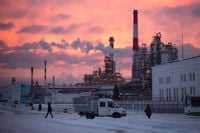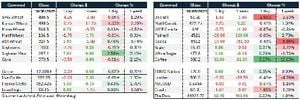In a dramatic escalation of the ongoing conflict between Russia and Ukraine, the reverberations of drone warfare are now being felt far beyond the frontlines. Over the past weeks, a series of targeted drone strikes have not only battered energy infrastructure in both countries but also sent shockwaves through global energy markets, upending established dynamics and raising urgent questions about the future of regional security and economic stability.
On August 18, 2025, Russian drone attacks struck a particularly sensitive target in Odesa, Ukraine: a storage facility operated by Azerbaijan’s state oil company SOCAR. According to preliminary assessments cited by The Kyiv Independent, the strike destroyed all 17 fuel tanks, a pumping station, and operational facilities at the site, wiping out a total storage capacity exceeding 16,000 cubic meters. This devastating blow came just ten days after an earlier assault on the same facility, when about ten drones targeted its critical infrastructure.
The repetition and precision of these attacks have led Ukrainian officials to conclude that they are anything but accidental. In a pointed phone call with his Azerbaijani counterpart Jeyhun Bayramov, Ukraine’s Foreign Minister Andriy Sybiha called the strikes on SOCAR and the Orlivka terminal "deliberate and unacceptable," signaling a belief in Kyiv that Moscow’s aims extend beyond mere military objectives. Instead, the attacks are being interpreted as calculated acts of pressure against Azerbaijan—a country whose growing influence in global energy markets has become a thorn in the Kremlin’s side.
The diplomatic fallout was swift. On August 10, Presidents Ilham Aliyev of Azerbaijan and Volodymyr Zelensky of Ukraine issued a joint condemnation of the Russian attacks, reaffirming that these aggressive actions would not deter or alter the course of Baku–Kyiv cooperation. The timing was particularly notable, coinciding as it did with the much-watched Trump–Putin meeting in Alaska. Analysts suggest that Moscow may have been sending a not-so-subtle message: Russia remains capable of disrupting the interests of third-party states, especially those seen as drifting toward the West.
But if the Kremlin’s intent was to intimidate or isolate Azerbaijan, the strategy appears to have backfired. As The Kyiv Independent and regional experts point out, Azerbaijan has only doubled down on its efforts to diversify partnerships and strengthen its ties with Western actors. This comes at a moment when Western companies, including ExxonMobil, are reportedly eyeing Azerbaijan’s "Karabakh" oil field, further eroding Russia’s traditional dominance over the Caspian energy map. For Moscow, these developments represent not just a loss of economic leverage but a symbolic defeat in the struggle for influence over Eurasian energy routes.
Yet the story doesn’t end there. The fallout from these strikes is rippling back into Russia itself, where the economic consequences are mounting. On August 18—the same day as the Odesa attack—wholesale gasoline prices in Russia surged to historic highs, according to The Moscow Times. On the St. Petersburg International Mercantile Exchange, the cost of Ai-92 gasoline hit 71,500 rubles ($888) per ton, while Ai-95 soared to 80,430 rubles ($999) per ton. These figures mark increases of up to 2.2% in a single day, and staggering jumps of 38% and 49% respectively since the start of 2025.
What’s driving this spike? Ukrainian forces have dramatically ramped up their campaign against Russian energy facilities, targeting not only military supply lines but also the economic arteries that fund the Kremlin’s war effort. Since early August, Ukrainian drones have struck multiple Russian refineries, including Rosneft’s plants in Novokuybyshevsk and Saratov, as well as Lukoil’s Volgograd refinery—the largest in southern Russia and among the top ten nationwide. The most recent strikes have also hit the Russian port of Olya in Astrakhan Oblast, a key hub for Iranian-made Shahed drones, and refineries in Volgograd, Saratov, and Syzran.
The impact has been immediate and severe. In occupied Crimea and parts of Zabaykalsky Krai, Ai-95 gasoline has reportedly vanished from most filling stations or is being rationed by coupons to enterprises, according to local reports. The Russian Energy Ministry, for its part, insists that "the situation is under control," claiming that supply is sufficient, domestic deliveries are increasing, and no logistical problems are being observed. However, the numbers tell a different story, and the sense of unease is palpable across the country.
Ukraine’s military, emboldened by the success of its long-range strikes, reported on August 15 that its 2025 campaign has inflicted losses worth approximately $74.1 billion on Russia—about 4.11% of the country’s annual GDP. Oil refineries have been the most common targets, accounting for 42% of attacks this year. This economic toll is not lost on policymakers or ordinary Russians, who are feeling the pinch at the pump and watching nervously as their country’s energy infrastructure is battered by a relentless barrage of Ukrainian drones.
The broader geopolitical implications are hard to overstate. By targeting SOCAR facilities in Ukraine, Russia is signaling its willingness to escalate not only against Kyiv but also against third-party states whose interests intersect with the West. Yet, as The Kyiv Independent and other observers have noted, such coercive tactics often produce the opposite of their intended effect. Rather than cowing Azerbaijan, these attacks have only strengthened its resolve to seek out new partnerships and assert its independence on the world stage.
Meanwhile, the escalating energy war is reshaping markets and alliances. With Russian gasoline prices at record highs and supplies dwindling in some regions, the pressure is mounting on the Kremlin to find new ways to shore up its economy and maintain domestic stability. For Ukraine, the success of its drone campaign offers both a strategic advantage and a powerful bargaining chip in its ongoing struggle for sovereignty and security.
As the conflict grinds on, one thing is clear: the era of energy as a weapon is far from over. The strikes on SOCAR and Russian refineries are not just isolated incidents; they are harbingers of a new phase in the war, where economic targets are as important as military ones, and the consequences are felt from Odesa to Moscow—and far beyond.
In this rapidly shifting landscape, the resilience of Azerbaijan, the ingenuity of Ukrainian forces, and the vulnerabilities of the Russian energy sector are all being tested as never before. The coming months promise more turbulence, as each side recalibrates its strategies and the world watches to see who will emerge stronger from this high-stakes contest.




